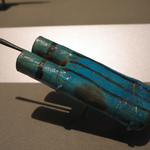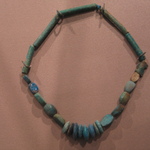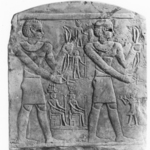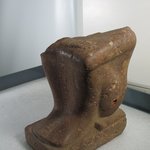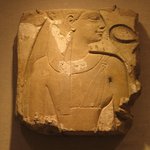Shabti of Senkamanisken
Egyptian, Classical, Ancient Near Eastern Art
On View: Egyptian Orientation Gallery, 3rd Floor
ART OF WRITING
Both of these works, separated by many centuries, use the human body as a platform for expressing and displaying script.
Shabtis are funerary figures intended to do the agricultural work the gods might require of the deceased, represented here holding hoes. The hieroglyphic inscription on this figure is a spell from the Book of the Dead, asking the shabti to do the Nubian king Senkamanisken’s work for him in the afterlife.
Owusu-Ankomah's paintings depict a spiritual world occupied by people and symbols. The male figure in this work is covered by, and moves within, Akan adinkra symbols from the artist's native Ghana, each of which graphically represents a particular concept or proverb. Looking Back Into the Future depicts a nude man with his head turned backward, in a pose associated with the Akan proverbial concept of sankofa ("one must know the past to know the future").
You can see a contemporary version of adinkra cloth among the "touch" textiles around the corner.
MEDIUM
Steatite
DATES
643–623 B.C.E.
DYNASTY
Dynasty 26
PERIOD
Napatan Period
DIMENSIONS
8 9/16 x 2 11/16 x depth at base 1 15/16 in. (21.7 x 6.9 x 5 cm)
(show scale)
ACCESSION NUMBER
39.5
CREDIT LINE
By exchange
PROVENANCE
Pyramid III, Nuri necropolis, Napata, Nubia (modern Sudan); before 1939, excavated by George Andrew Reisner for the MFA, Boston, MA; 1939, purchased from the MFA, Boston by the Brooklyn Museum, by exchange.
Provenance FAQ
CATALOGUE DESCRIPTION
Mottled gray limestone (?) ushabti of Senkaman-seken (633-613 BC). The figure is freestanding with royal headdress with two uraeus, hands opposite in an unnatural position bearing a whip and a crook. No cords indicated. Inscription divided into six horizontal registers. Workmanship excellent. Peculiar markings on the base (possibly those of a craftsman).
Condition: Perfect excepting base of beard is broken.
CAPTION
Nubian. Shabti of Senkamanisken, 643–623 B.C.E. Steatite, 8 9/16 x 2 11/16 x depth at base 1 15/16 in. (21.7 x 6.9 x 5 cm). Brooklyn Museum, By exchange, 39.5. Creative Commons-BY (Photo: Brooklyn Museum, 39.5_edited_SL3.jpg)
IMAGE
overall, 39.5_edited_SL3.jpg. Brooklyn Museum photograph
"CUR" at the beginning of an image file name means that the image was created by a curatorial staff member. These study images may be digital point-and-shoot photographs, when we don\'t yet have high-quality studio photography, or they may be scans of older negatives, slides, or photographic prints, providing historical documentation of the object.
RIGHTS STATEMENT
Creative Commons-BY
You may download and use Brooklyn Museum images of this three-dimensional work in accordance with a
Creative Commons license. Fair use, as understood under the United States Copyright Act, may also apply.
Please include caption information from this page and credit the Brooklyn Museum. If you need a high resolution file, please fill out our online
application form (charges apply).
For further information about copyright, we recommend resources at the
United States Library of Congress,
Cornell University,
Copyright and Cultural Institutions: Guidelines for U.S. Libraries, Archives, and Museums, and
Copyright Watch.
For more information about the Museum's rights project, including how rights types are assigned, please see our
blog posts on copyright.
If you have any information regarding this work and rights to it, please contact
copyright@brooklynmuseum.org.
RECORD COMPLETENESS
Not every record you will find here is complete. More information is available for some works than for others, and some entries have been updated more recently. Records are frequently reviewed and revised, and
we welcome any additional information you might have.








